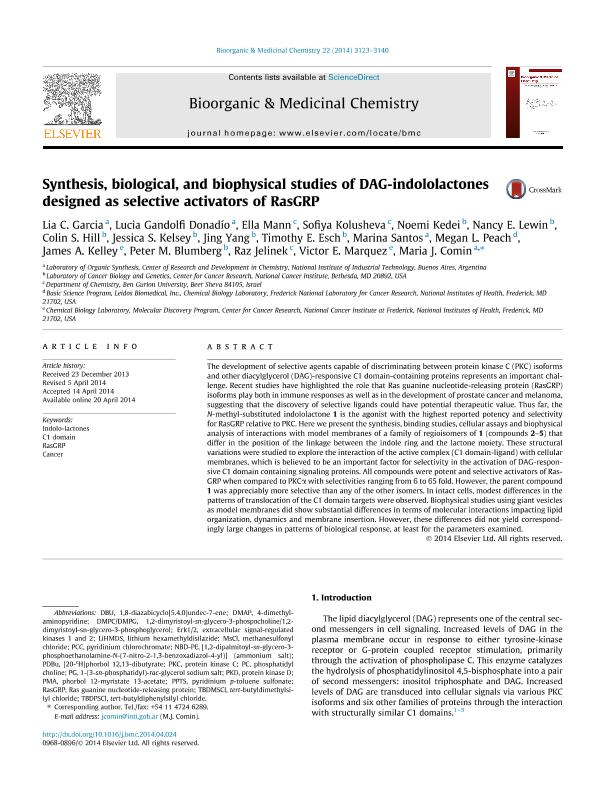Artículo
Synthesis, biological, and biophysical studies of DAG-indololactones designed as selective activators of RasGRP
Garcia, Lia C.; Gandolfi Donadío, Lucía ; Mann, Ella; Kolusheva, Sofiya; Kedei, Noemi; Lewin, Nancy E.; Hill, Collin S.; Kelsey, Jessica S.; Yang, Jing; Esch, Timothy E.; Santos, Marina; Peach, Megan L.; Kelley, James A.; Blumberg, Peter M.; Jelinek, Raz; Marquez, Victor E.; Comin, Maria Julieta
; Mann, Ella; Kolusheva, Sofiya; Kedei, Noemi; Lewin, Nancy E.; Hill, Collin S.; Kelsey, Jessica S.; Yang, Jing; Esch, Timothy E.; Santos, Marina; Peach, Megan L.; Kelley, James A.; Blumberg, Peter M.; Jelinek, Raz; Marquez, Victor E.; Comin, Maria Julieta
 ; Mann, Ella; Kolusheva, Sofiya; Kedei, Noemi; Lewin, Nancy E.; Hill, Collin S.; Kelsey, Jessica S.; Yang, Jing; Esch, Timothy E.; Santos, Marina; Peach, Megan L.; Kelley, James A.; Blumberg, Peter M.; Jelinek, Raz; Marquez, Victor E.; Comin, Maria Julieta
; Mann, Ella; Kolusheva, Sofiya; Kedei, Noemi; Lewin, Nancy E.; Hill, Collin S.; Kelsey, Jessica S.; Yang, Jing; Esch, Timothy E.; Santos, Marina; Peach, Megan L.; Kelley, James A.; Blumberg, Peter M.; Jelinek, Raz; Marquez, Victor E.; Comin, Maria Julieta
Fecha de publicación:
06/2014
Editorial:
Pergamon-Elsevier Science Ltd.
Revista:
Bioorganic & Medicinal Chemistry
ISSN:
0968-0896
Idioma:
Inglés
Tipo de recurso:
Artículo publicado
Clasificación temática:
Resumen
The development of selective agents capable of discriminating between protein kinase C (PKC) isoforms and other diacylglycerol (DAG)-responsive C1 domain-containing proteins represents an important challenge. Recent studies have highlighted the role that Ras guanine nucleotide-releasing protein (RasGRP) isoforms play both in immune responses as well as in the development of prostate cancer and melanoma, suggesting that the discovery of selective ligands could have potential therapeutic value. Thus far, the N-methyl-substituted indololactone 1 is the agonist with the highest reported potency and selectivity for RasGRP relative to PKC. Here we present the synthesis, binding studies, cellular assays and biophysical analysis of interactions with model membranes of a family of regioisomers of 1 (compounds 2–5) that differ in the position of the linkage between the indole ring and the lactone moiety. These structural variations were studied to explore the interaction of the active complex (C1 domain-ligand) with cellular membranes, which is believed to be an important factor for selectivity in the activation of DAG-responsive C1 domain containing signaling proteins. All compounds were potent and selective activators of RasGRP when compared to PKCα with selectivities ranging from 6 to 65 fold. However, the parent compound 1 was appreciably more selective than any of the other isomers. In intact cells, modest differences in the patterns of translocation of the C1 domain targets were observed. Biophysical studies using giant vesicles as model membranes did show substantial differences in terms of molecular interactions impacting lipid organization, dynamics and membrane insertion. However, these differences did not yield correspondingly large changes in patterns of biological response, at least for the parameters examined.
Palabras clave:
Indolo-Lactones
,
C1 Domain
,
Rasgrp
,
Cancer
Archivos asociados
Licencia
Identificadores
Colecciones
Articulos(SEDE CENTRAL)
Articulos de SEDE CENTRAL
Articulos de SEDE CENTRAL
Citación
Garcia, Lia C.; Gandolfi Donadío, Lucía; Mann, Ella; Kolusheva, Sofiya; Kedei, Noemi; et al.; Synthesis, biological, and biophysical studies of DAG-indololactones designed as selective activators of RasGRP; Pergamon-Elsevier Science Ltd.; Bioorganic & Medicinal Chemistry; 22; 12; 6-2014; 3123-3140
Compartir
Altmétricas



